
Digital Visual Interface (DVI) is a video display interface developed by the Digital Display Working Group (DDWG). The digital interface is used to connect a video source, such as a video display controller, to a display device, such as a computer monitor. It was developed with the intention of creating an industry standard for the transfer of uncompressed digital video content.
The Display Data Channel, or DDC, is a collection of protocols for digital communication between a computer display and a graphics adapter that enable the display to communicate its supported display modes to the adapter and that enable the computer host to adjust monitor parameters, such as brightness and contrast.
Apple Inc. has sold a variety of LCD and CRT computer displays. Apple paused production of their own standalone displays in 2016 and partnered with LG to design displays for Macs. In June 2019, the Pro Display XDR was introduced, however it was expensive and targeted for professionals. Nearly three years later, in March 2022, the Studio Display was launched as a consumer-targeted counterpart to the professional monitor. These two are currently the only Apple-branded displays available.

High-Definition Multimedia Interface (HDMI) is a proprietary audio/video interface for transmitting uncompressed video data and compressed or uncompressed digital audio data from an HDMI-compliant source device, such as a display controller, to a compatible computer monitor, video projector, digital television, or digital audio device. HDMI is a digital replacement for analog video standards.
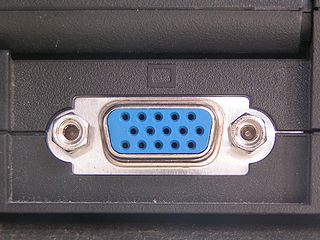
The Video Graphics Array (VGA) connector is a standard connector used for computer video output. Originating with the 1987 IBM PS/2 and its VGA graphics system, the 15-pin connector went on to become ubiquitous on PCs, as well as many monitors, projectors and high-definition television sets.

The Power Mac G4 is a series of personal computers designed, manufactured, and sold by Apple Computer from 1999 to 2004 as part of the Power Macintosh line. Built around the PowerPC G4 series of microprocessors, the Power Mac G4 was marketed by Apple as the first "personal supercomputers", reaching speeds of 4 to 20 gigaFLOPS. This was the first existing Macintosh product to be officially shortened as "Mac", and is the last Mac able to boot into classic Mac OS.
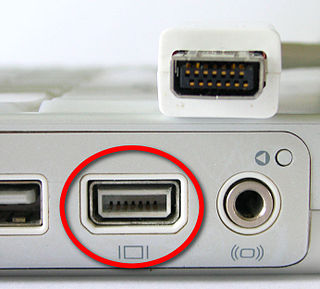
Mini-VGA connectors are a non-standard, proprietary alternative used on some laptops and other systems in place of the standard VGA connector, although most laptops use a standard VGA connector. Apple, HP and Asus have separate implementations using the same name. Apart from its compact form, mini-VGA ports have the added ability to output both composite and S-Video in addition to VGA signals through the use of EDID.
An output device is any piece of computer hardware that converts information/DATA into a human-perceptible form or, historically, into a physical machine-readable form for use with other non-computerized equipment. It can be text, graphics, tactile, audio, or video. Examples include monitors, printers, speakers, headphones, projectors, GPS devices, optical mark readers, and braille readers.

The Apple Cinema Display is a line of flat-panel computer monitors developed and sold by Apple Inc. between 1999 and 2011. It was initially sold alongside the older line of Studio Displays, but eventually replaced them. Apple offered 20, 22, 23, 24, 27, and 30-inch sizes, with the last model being a 27-inch size with LED backlighting.

DB13W3 (13W3) is a style of D-subminiature connector used for analog video interfaces. The 13 refers to the total number of pins, the W refers to workstation and the 3 refers to the number of high-frequency pins. The connector was something of a pseudo-standard for high-end graphical workstations from the early 1990s to the early 2000s.
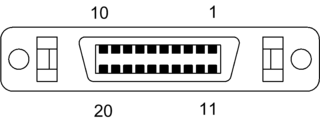
The VESA Digital Flat Panel (DFP) interface standard specifies a video connector and digital TMDS signaling for flat-panel displays. It features 20 pins and uses the PanelLink protocol; the standard is based on the preceding VESA Plug and Display (P&D) standard, ratified in 1997. Unlike the later, electrically-compatible Digital Visual Interface, DFP never achieved widespread implementation.

DisplayPort (DP) is a digital display interface developed by a consortium of PC and chip manufacturers and standardized by the Video Electronics Standards Association (VESA). It is primarily used to connect a video source to a display device such as a computer monitor. It can also carry audio, USB, and other forms of data.
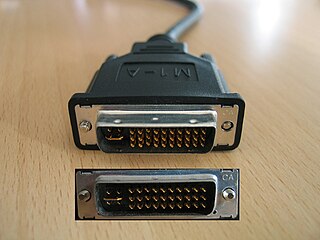
VESA Plug and Display is a video connector that carries digital signals for monitors, such as flat panel displays and video projectors, ratified by Video Electronics Standards Association (VESA) in 1997. Introduced around the same time as the competing connectors for the Digital Visual Interface and VESA's own Digital Flat Panel, it was marketed as a replacement for the VESA Enhanced Video Connector. Unlike DVI, it never achieved widespread implementation.

The Mini-DVI connector is used on certain Apple computers as a digital alternative to the Mini-VGA connector. Its size is between the full-sized DVI and the tiny Micro-DVI. It is found on the 12-inch PowerBook G4, the Intel-based iMac, the MacBook Intel-based laptop, the Intel-based Xserve, the 2009 Mac mini, and some late model eMacs.

Target Disk Mode is a boot mode unique to Macintosh computers.

The Dreamcast VGA Box is an accessory for Sega's Dreamcast video game console that allows it to connect to a video display such as a computer monitor or an HDTV set through a VGA port. Because the Dreamcast hardware can produce a VGA-compatible video signal natively, this connection provides improved picture quality compared to standard composite video or S-Video connections, along with support for progressive scan video.

The Mini DisplayPort is a miniaturized version of the DisplayPort audio-visual digital interface.
Audio connectors and video connectors are electrical or optical connectors for carrying audio or video signals. Audio interfaces or video interfaces define physical parameters and interpretation of signals. For digital audio and digital video, this can be thought of as defining the physical layer, data link layer, and most or all of the application layer. For analog audio and analog video these functions are all represented in a single signal specification like NTSC or the direct speaker-driving signal of analog audio.

The Apple Studio Display is a series of non-widescreen LCD and CRT displays manufactured and sold by Apple Computer, Inc. and introduced in 1998. After the 1999 introduction of the widescreen Apple Cinema Display, the Apple Studio Display line ran concurrently until it was discontinued in 2004. With the exception of the last model, the 5:4 17" Apple Studio Display, all Apple Studio Displays had an aspect ratio of 4:3.
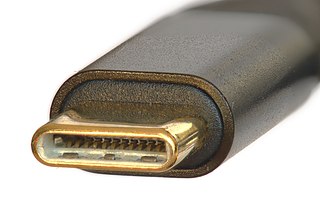
USB-C, or USB Type-C, is a connector that supersedes previous USB connectors and can carry audio and/or video data, e.g. to drive multiple displays, or transfer data, e.g. to store a backup to an external drive, and providing/receiving power, such as to power a laptop or a mobile phone. It is applied not only by USB technology, but also by other protocols, including Thunderbolt, PCIe, HDMI, DisplayPort, and others. It is extensible to support future standards.

















